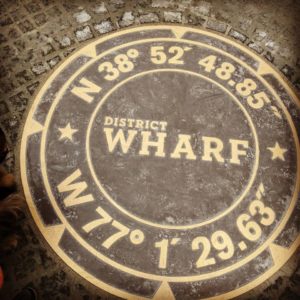
Coordinates of District Wharf as seen on manhole covers throughout the property
Stroll down Wharf Street on any given evening and you will see locals and visitors, families with strollers and businessmen, cyclists and photographers. They are all coming down to District Wharf for a different reason—to capture that picture perfect sunset, try a dish at one of DC’s newest restaurants, or just to understand what all the buzz is about. In a way, this was the point of District Wharf, to serve as a connector for each person at that point in time, with the next visit being different from the last.
Since its opening a year ago, the Wharf has hosted over 10 million people. This figure includes attendees at events such as the sold-out opening night of the Anthem with the Foo Fighters, the 25th Annual District Holiday Boat Parade, a Mardi Gras Parade and celebration, the National Cherry Blossom Festival’s Petalpalooza, and DC Jazz Fest. These events have become part of the backbone of the Wharf’s tagline “Where DC Meets…,” with each event providing a different experience and viewpoint for the visitor. The role of events has created a living, breathing development, adding to the excitement of a daytime visit or the liveliness of an evening at the Wharf.
The Wharf is challenging the public to think about modes of transportation and how cars and pedestrians interact in the city. Along cobblestone Wharf Street, both vehicles and pedestrians share a space known as “woonerf,” a European-style of street that when translated from Dutch means “living yard.” The Wharf is not the only area in the city to have this controversial style of street, but it may be the one that has created the loudest conversation in the city about curbless environments and precautions that are needed. The Wharf now closes Wharf Street to cars on the weekend and during key events, when foot traffic is at its heaviest. On the Maine Avenue side, it has also created a designated and marked two-way bike lane complete with dotted lines, which is separate from walkers. However, with the bike lane on the outside, pedestrians entering and exiting ride share and taxis must cross the bike lanes, and most may not even be aware of what they are crossing. Now that these areas exist, they have provided an opportunity for the city to use them as case studies when discussing improvements to pedestrian infrastructure.
The Wharf has reintroduced Washington to the power of the water. Bright yellow water taxis have seen a large increase in ridership that continues to grow, taking passengers from Southwest to Old Town Alexandria in 30 minutes (passengers can also choose to visit National Harbor or Georgetown directly from the Wharf). Visitors (and their dogs!) can take the free Jitney across the Washington Channel to East Potomac Park in just a handful of minutes. Earlier this year the Wharf welcomed a 175-person cruise ship (the first in 55 years) and this month, the Wharf will even welcome the world’s largest Viking ship for 10 days.
The Wharf has also reintroduced the history of the Southwest Waterfront to the city at large. Plaques mark notable locations of the old waterfront throughout history. Highlighting locations such as the District Morgue and The Pearl helps remind visitors that what stands today is in part due to those who came before—residents and business owners that helped make history in their neighborhoods. And while residents may no longer be able to enjoy Hogate’s famous rum buns, new restaurants coming to the Wharf are hoping to become the next neighborhood favorite.
A new sushi spot, Tabu, is set to open by the end of 2018, with Sushi Taro chef Nobu Yamazaki at the helm. Rappahannock Oyster Company is set to open soon in the restored historic oyster shed. Potomac Distilling Company, which will feature a three-story rum distillery, is set to open any day now with “Rum Not War” painted down the side of the smokestack. These restaurants, and those already at the Wharf, will continue to highlight eating as an experience, a social act. Each restaurant’s position seems designed to put diners in the middle of the atmosphere, with music, pedestrians and water surrounding the meal, all joining together to create a once-in-a-lifetime experience along the Southwest Waterfront.
Phase II, which has already begun with the installation of the new docks where Cantina Marina used to be, will not just feel different, but it will also have different offerings than Phase I: a small grocer, a restaurant on the water and a small boutique hotel. Much like the first phase, the retail and experiences that visitors will enjoy with Phase II are evolving to fit the needs of the public and the neighborhood.
The Wharf has literally changed the shape of the Southwest Waterfront. When both phases are fully complete by the end of 2021, there will be no distinction between the two. The one-mile stretch over 24 acres of land will include 10 acres of parks and 50 acres of water rights in the Washington Channel. It aims to cohesively reconnect the city and the people to its Southwest Waterfront for the next chapter of the neighborhood’s long history.
BY Katelynd Mahoney Anderson

